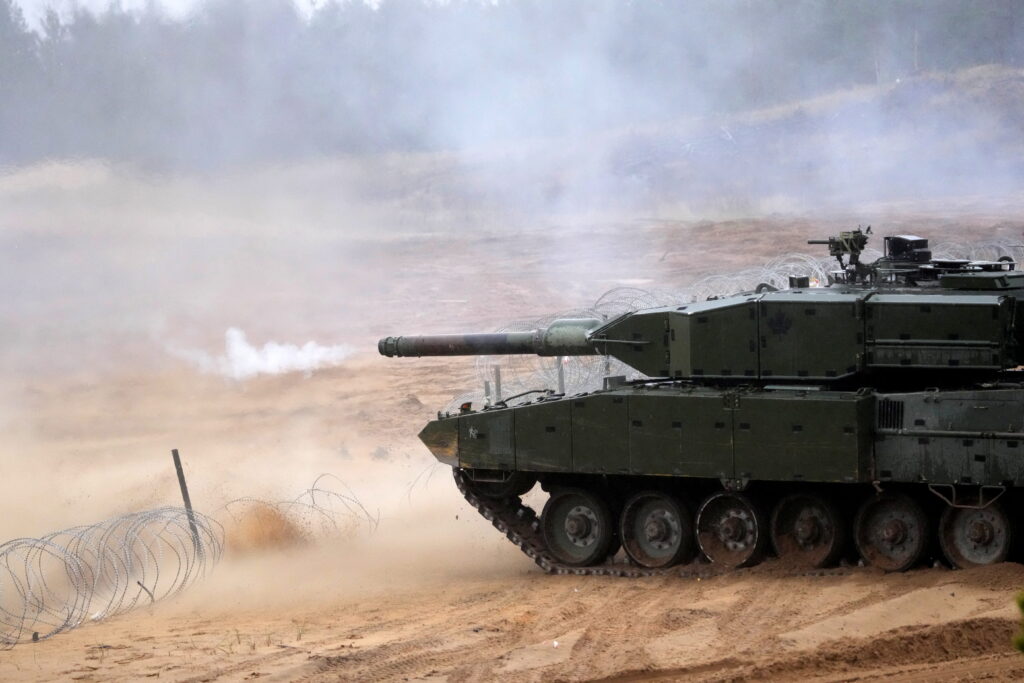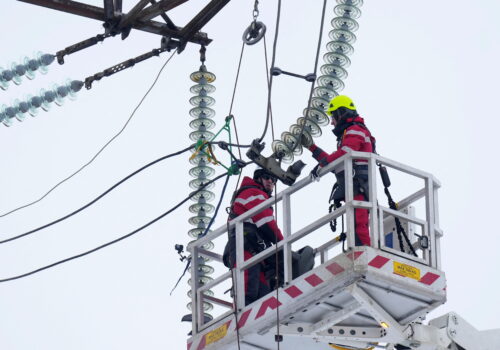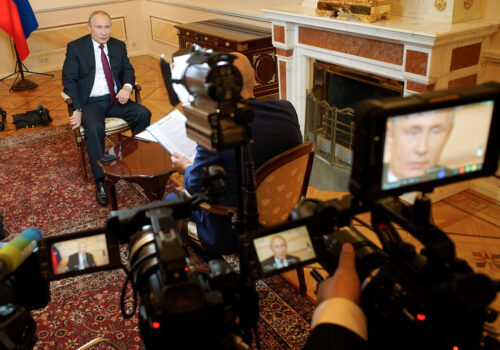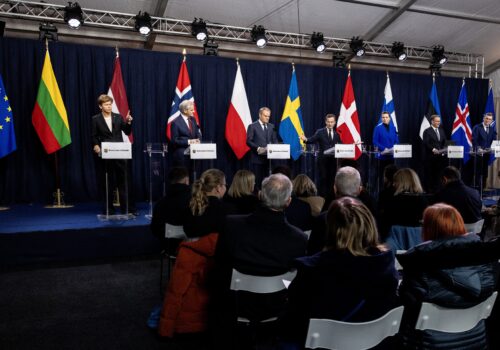This project, a collaboration between the Atlantic Council’s Transatlantic Security Initiative and the Latvia-based Centre for East European Policy Studies, aims to advance understanding of Latvia’s defense and security policies, with an emphasis on resilience-building strategies. Latvia’s measures offer lessons for other frontline states, and demonstrate an increasing willingness to prioritize defense in an uncertain geopolitical environment. Read the other articles in this series here and here.
Russia’s full-scale war against Ukraine has laid bare Moscow’s neo-imperial ambitions and the direct threat it poses to its so-called near-abroad. For NATO frontline states such as Latvia, the security landscape has fundamentally changed over the past three years. While Russian forces are currently taking staggering losses in Ukraine, necessitating a period of force reconstitution, Russia’s military could be rebuilt and ready to invade a Baltic state in as few as three years, according to estimates from some Western intelligence agencies.
Other factors complicate the picture further. On the positive side, the accession of Finland and Sweden to the Alliance, growing defense capabilities in neighboring Estonia and Lithuania, and Poland’s significant defense investments, all provide Latvia with a strengthened collective defense posture in the Baltic Sea region. However, this has occurred amid growing uncertainty regarding the United States’ long-term commitment to European security. Critical US enablers and rapid reinforcements cannot be taken for granted to the same degree as in the past. While the US nuclear umbrella remains extended so far, the erosion of trust is noticeable, creating potential vulnerabilities that the Kremlin might seek to test.
The stakes could not be higher. For Latvia and its Baltic neighbors, Russian aggression represents an existential threat. At the same time, a Russian attack on NATO’s eastern flank would quickly reverberate across the entire Alliance.
In response to these threats and changing security dynamics, Latvia should pursue three fundamental and interconnected strategic goals:
- First, demonstrate political will: Latvia must demonstrate to allies in Washington and across Europe that it is maximizing its own defense capabilities and resilience, shouldering its share of the burden, and signaling unwavering commitment. It must then use that demonstration to harness the power of the Alliance for its national defense. Latvia’s defense budget hovered around 1 percent of gross domestic product (GDP) in 2014 when Russia first invaded Crimea. Its defense budget this year is set at about 3.65 percent, with announced plans to push it to 5 percent of GDP soon. Latvia needs to make up for lost time.
- Second, generate sufficient capabilities: Riga needs to generate sufficient domestic defensive capabilities, integrated with NATO’s Enhanced Forward Presence battlegroup, to realistically hold a defensive line against aggression long enough for decisive allied reinforcements to arrive. It needs to achieve a degree of deterrence by denial. This will require a significant Latvian military buildup.
- Third, enhance societal resilience: Latvia must also project an undeniable national will, making it clear to Moscow that any aggression would face fierce, protracted, whole-of-society, and costly resistance. There can be no perception of Latvia as an easy target.
Achieving these goals demands immediate, focused action in Latvia, as well as a rallying of Riga’s NATO allies.
National defense priorities
Latvia should begin by making its comprehensive defense concept a nationwide reality. The 2018 adoption of this framework, which called for integrating civilian elements into national security, is its vital strength. Through this whole-of-society approach, Latvia has demonstrated ingenuity and cooperation. For example, Latvia’s municipalities and state companies collaborate to support armed forces mobility and counter-mobility efforts. Another example is the involvement of hunters in the national defense system—as a patriotic and armed part of society that can be integrated with the National Guard and tasked with support assignments. While these efforts are commendable, more must be done to ensure that civilian agencies, businesses, and citizens are actively integrated into national resilience and defense planning through practical taskings and drills. As comprehensive defense evolves into the reality of society, it demonstrates credible national will, complicates adversary planning, and builds the societal backbone needed to withstand pressure and deter aggression, including hybrid attacks from Russia.
Latvia must also maintain momentum and keep military modernization on track. Since Russia’s full-scale invasion of Ukraine, Latvia has significantly increased investment in conventional war-fighting capabilities. Riga’s commitment to acquiring advanced systems such as HIMARS rocket launchers, IRIS-T air-to-air missiles, and coastal defense missiles sends a vital message: the country is serious about bolstering deterrence by denial. However, acquiring advanced hardware is only part of the equation; Latvia must also ensure that these systems can be effectively commanded, supplied, and maintained during high-intensity conflict. This necessitates trained personnel and critical support elements, including robust command-and-control, resilient logistics, sufficient ammunition stockpiles, and effective maintenance infrastructure. Not all equipment needs to be expensive or high-tech. Land mines along the border that would channel an attack and swarms of low-cost drones can have dramatic results on the battlefield. Perhaps most important, Latvia must ensure that it can sustain combat operations beyond the initial phase, proving it possesses the national endurance required to hold the line until allied reinforcements arrive.
National resilience also requires forging a cohesive fighting force from diverse sources of manpower. In 2023, Latvia introduced a mandatory conscription policy called State Defense Service (SDS) to bolster recruitment. This policy of mandatory eleven-month service has shown early signs of success. Latvia is planning to enlist four thousand new recruits annually by 2028, and 40 percent of the 2024 intake opted for professional careers after their mandatory service. However, given Latvia’s demographics, active service alone cannot generate sufficient manpower; it must be complemented by a ready and responsive reserve system—one that currently requires significant overhaul. With SDS providing a new input stream, the reserve system must be adapted to effectively integrate these personnel and grow combat power over the long term. Latvia could add significantly to its manpower mobilization by combining professionals, the Home Guard, and SDS graduates, as well as by implementing dedicated reservist training and early military education. Current military plans envision 31,000 troops by 2029, plus an equally large reserve contingent thereafter. While this objective is sound, the current timeline appears misaligned with the potential speed of Russian force reconstitution. Latvia must confront substantial constraints, including the need for adequate infrastructure, qualified instructors, and innovative policies to drive recruitment and conduct training at the required scale and speed.
Furthermore, physical defenses require turning the Baltic Defense Line from a concept to a concrete plan. A fortified line across the Baltics, leveraging naturally difficult terrain, is a clear-headed and necessary response to the Russian threat. Correctly executed, it could effectively impede a potential incursion, buying time for national counteractions and allied mobilization. Fast-tracking construction, funding, and policy decisions will be crucial for realizing this critical barrier. Critically, forces must train to fight effectively from these prepared positions, integrating them fully into national and regional operational plans.
Finally, Latvia must ensure that it has the infrastructure to support military mobility and to provide host nation support. Latvia’s defense fundamentally relies on NATO allies arriving quickly and in force, requiring substantial investment in mobility infrastructure and support elements. Latvia must therefore proactively invest in and expand the critical infrastructure needed to receive, stage, and sustain large-scale allied forces. Short-term priorities include accelerating projects like the Liepāja military port and enhancing airfield capacity at Lielvārde airbase and Riga International Airport. Accelerating Rail Baltica’s military utility is also crucial, as it could fundamentally alter the capacity and speed of NATO reinforcements into the region.
Rallying allied support
While Latvia shoulders these critical domestic responsibilities, its security ultimately rests on robust collective defense and the tangible commitment of its allies. Latvia must advocate for specific actions from its NATO partners, recognizing that the window before Russia potentially reconstitutes its offensive capabilities is short. This diplomatic push requires urgency and clarity.
The place to begin is in Washington. All three Baltic states and Poland have essentially accepted US President Donald Trump’s challenge for allies to spend 5 percent of GDP on defense. This should be presented in a high-profile fashion to Trump during the NATO Summit in June. As part of this presentation, Latvia should urge Trump to continue hosting US forces in the Baltic region on a rotational basis and to augment those rotations with high-impact capabilities such as air and missile defense assets.
To deter Russia, NATO must strengthen its forward defense posture on the ground. Latvia should continue advocating for transforming the Enhanced Forward Presence battlegroup on its territory into a combat-credible forward defense force that expands on the full-time brigade and integrates it with national defense structures that match adversary military capabilities. Enhancing this forward defense by securing broader participation, particularly from a nuclear-armed European ally, would send a strong deterrent signal to Moscow.
This enhanced forward presence must be embedded within deeper, more integrated regional defense planning. Latvia, working closely with its neighbors, should champion the development of genuinely interlocking, all-domain defense plans within an enhanced Nordic-Baltic-Poland framework. This necessitates moving beyond interoperability exercises toward shared operational concepts and assigned responsibilities. This will help forge a more cohesive and resilient defense architecture in NATO’s northeast as part of the Alliance’s broader reinforcement strategy. Consequently, Latvia must be a vocal proponent of the regular, rigorous exercising and continuous streamlining of the supreme allied commander Europe’s reinforcement plans for the Baltic region. Identifying and resolving friction points, especially cross-border military mobility bottlenecks and logistical hurdles, requires sustained, collaborative effort with those allies designated to reinforce the region in a crisis.
Minimizing the time required for those reinforcements to arrive necessitates a concerted push to maximize the pre-positioning of allied military equipment and essential stocks within Latvia and the region. Reducing the lift requirement during a crisis by having equipment already in theater dramatically shortens response timelines, directly bolstering deterrence by showcasing NATO’s capacity for rapid, large-scale reaction.
Lastly, building on a deep-seated relationship, the Baltic states must treat strengthening security cooperation with Ukraine as a long-term strategic imperative. Currently, Kyiv’s resolute defense delivers immediate dividends by tying down significant Russian forces and offering invaluable, hard-earned combat lessons. For the Baltic states, a battle-hardened ally such as Ukraine can be a substantial security and defense contributor to the region. If Russia were to test NATO’s defense capabilities on its eastern flank, the prospect of Ukraine joining the fight would dramatically expand Moscow’s theater of operations.
Latvia has a brief respite as Russian troops are worn down in Ukraine, but it will take little time for Russia to reconstitute its conventional forces. Latvia must use this window to create a more favorable defense environment. At home, it must rapidly build up its defense capacity and resilience. Abroad, it needs to assure a continued US commitment to its defense, generate a greater NATO forward presence on its soil, and deepen regional integration. It also needs to refine reinforcement mechanisms and maximize pre-positioning. Convincing allies to commit the necessary political will and resources before Russia regains its strength is the most critical security task facing Riga and its regional partners.
Armands Astukevičs is a researcher at the Centre for East European Policy Studies. His primary research focuses on the Baltic states’ defense and security, as well as the foreign and security policies of Russia and Belarus. Previously, he worked on policy analysis and planning at the Latvian Ministry of Defence, focusing on crisis management and comprehensive national defence issues.
Hans Binnendijk is a distinguished fellow at the Atlantic Council’s Scowcroft Center for Strategy and Security. He previously served in several senior US government positions, including special assistant to the president for defense policy, principal deputy director of the State Department Policy Planning Staff, and director of the Institute for National Security Studies.
Further reading
Wed, May 7, 2025
Lessons from Latvia’s efforts to keep essential services running during a crisis
New Atlanticist By
Latvia has shifted its crisis-management thinking from a focus on infrastructure protection to an emphasis on continuity of essential services and functions.
Mon, May 5, 2025
What’s the best way to deal with Russian information manipulation? Latvia has answers.
New Atlanticist By
By combining policy tools, public education, media support, active debunking, and international partnerships, Latvia has built a layered defense.
Wed, Dec 4, 2024
How the Nordic-Baltic states are leading the way on European security
New Atlanticist By Anna Wieslander
Denmark, Estonia, Finland, Iceland, Latvia, Lithuania, Norway, and Sweden are becoming increasingly significant to security on the continent.
Image: Canadian army Leopard 2 tank attends NATO Enhanced Forward Presence battle group "Resolute Warrior" military exercise in Adazi, Latvia November 14, 2024. REUTERS/Ints Kalnins




